Profiling the Atopic Dermatitis Epidermal Transcriptome by Tape Stripping and BRB-seq
Abstract
1. Introduction
2. Results
2.1. Characteristics of Subjects
2.2. BRB-seq and Data Quality Control
2.3. Detection of Skin Specific Genes by Tape Stripping
2.4. Benchmarking Data Normalization and Differential Expression Testing Methods
2.5. Atopic Dermatitis Gene Expression Signature Obtained by Tape Stripping
2.6. Differences between Tape Strip and Punch Biopsy-Derived Atopic Dermatitis Gene Signatures
3. Discussion
4. Materials and Methods
4.1. Collection of Tape Stripping and Sample Processing
4.2. BRB-seq and Data Processing
4.3. Four-Point Data Quality Control Scheme
4.4. Data Analysis
5. Conclusions
Supplementary Materials
Author Contributions
Funding
Institutional Review Board Statement
Informed Consent Statement
Data Availability Statement
Acknowledgments
Conflicts of Interest
References
- Langan, S.M.; Irvine, A.D.; Weidinger, S. Atopic Dermatitis. Lancet 2020, 396, 345–360. [Google Scholar] [CrossRef]
- Kim, B.E.; Leung, D.Y.M. Epidermal Barrier in Atopic Dermatitis. Allergy Asthma Immunol. Res. 2012, 4, 12. [Google Scholar] [CrossRef] [PubMed]
- Suárez-Fariñas, M.; Ungar, B.; Correa Da Rosa, J.; Ewald, D.A.; Rozenblit, M.; Gonzalez, J.; Xu, H.; Zheng, X.; Peng, X.; Estrada, Y.D.; et al. RNA Sequencing Atopic Dermatitis Transcriptome Profiling Provides Insights into Novel Disease Mechanisms with Potential Therapeutic Implications. J. Allergy Clin. Immunol. 2015, 135, 1218–1227. [Google Scholar] [CrossRef] [PubMed]
- Tsoi, L.C.; Rodriguez, E.; Degenhardt, F.; Baurecht, H.; Wehkamp, U.; Volks, N.; Szymczak, S.; Swindell, W.R.; Sarkar, M.K.; Raja, K.; et al. Atopic Dermatitis Is an IL-13–Dominant Disease with Greater Molecular Heterogeneity Compared to Psoriasis. J. Investig. Dermatol. 2019, 139, 1480–1489. [Google Scholar] [CrossRef]
- Wang, C.Y.; Maibach, H.I. Why Minimally Invasive Skin Sampling Techniques? A Bright Scientific Future. Cutan. Ocul. Toxicol. 2011, 30, 1–6. [Google Scholar] [CrossRef]
- Guttman-Yassky, E.; Diaz, A.; Pavel, A.B.; Fernandes, M.; Lefferdink, R.; Erickson, T.; Canter, T.; Rangel, S.; Peng, X.; Li, R.; et al. Use of Tape Strips to Detect Immune and Barrier Abnormalities in the Skin of Children with Early-Onset Atopic Dermatitis. JAMA Dermatol. 2019, 155, 1358–1370. [Google Scholar] [CrossRef]
- Yamaguchi, J.; Aihara, M.; Kobayashi, Y.; Kambara, T.; Ikezawa, Z. Quantitative Analysis of Nerve Growth Factor (NGF) in the Atopic Dermatitis and Psoriasis Horny Layer and Effect of Treatment on NGF in Atopic Dermatitis. J. Dermatol. Sci. 2009, 53, 48–54. [Google Scholar] [CrossRef]
- Xu, J.; Lu, H.; Luo, H.; Hu, Y.; Chen, Y.; Xie, B.; Du, X.; Hua, Y.; Song, X. Tape Stripping and Lipidomics Reveal Skin Surface Lipid Abnormity in Female Melasma. Pigment. Cell Melanoma Res. 2021, 34, 1105–1111. [Google Scholar] [CrossRef]
- Barnes, C.J.; Clausen, M.-L.; Asplund, M.; Rasmussen, L.; Olesen, C.M.; Yüsel, Y.T.; Andersen, P.S.; Litman, T.; Hansen, A.J.; Agner, T. Temporal and Spatial Variation of the Skin-Associated Bacteria from Healthy Participants and Atopic Dermatitis Patients. mSphere 2022, 7, e00917-21. [Google Scholar] [CrossRef]
- Olesen, C.M.; Pavel, A.B.; Wu, J.; Mikhaylov, D.; Del Duca, E.; Estrada, Y.; Krueger, J.G.; Zhang, N.; Clausen, M.L.; Agner, T.; et al. Tape-Strips Provide a Minimally Invasive Approach to Track Therapeutic Response to Topical Corticosteroids in Atopic Dermatitis Patients. J. Allergy Clin. Immunol. Pract. 2021, 9, 576–579.e3. [Google Scholar] [CrossRef]
- Olesen, C.M.; Fuchs, C.S.K.; Philipsen, P.A.; Hædersdal, M.; Agner, T.; Clausen, M.L. Advancement through Epidermis Using Tape Stripping Technique and Reflectance Confocal Microscopy. Sci. Rep. 2019, 9, 12217. [Google Scholar] [CrossRef] [PubMed]
- Alpern, D.; Gardeux, V.; Russeil, J.; Mangeat, B.; Meireles-Filho, A.C.A.; Breysse, R.; Hacker, D.; Deplancke, B. BRB-Seq: Ultra-Affordable High-Throughput Transcriptomics Enabled by Bulk RNA Barcoding and Sequencing. Genome Biol. 2019, 20, 71. [Google Scholar] [CrossRef] [PubMed]
- Sølberg, J.; Jacobsen, S.B.; Andersen, J.D.; Litman, T.; Ulrich, N.H.; Ahlström, M.G.; Kampmann, M.L.; Morling, N.; Thyssen, J.P.; Johansen, J.D. The Stratum Corneum Transcriptome in Atopic Dermatitis Can Be Assessed by Tape Stripping. J. Dermatol. Sci. 2021, 101, 14–21. [Google Scholar] [CrossRef] [PubMed]
- Dyjack, N.; Goleva, E.; Rios, C.; Kim, B.E.; Bin, L.; Taylor, P.; Bronchick, C.; Hall, C.F.; Richers, B.N.; Seibold, M.A.; et al. Minimally Invasive Skin Tape Strip RNA Sequencing Identifies Novel Characteristics of the Type 2–High Atopic Dermatitis Disease Endotype. J. Allergy Clin. Immunol. 2018, 141, 1298–1309. [Google Scholar] [CrossRef] [PubMed]
- Hu, T.; Todberg, T.; Ewald, D.A.; Hoof, I.; Correa Da Rosa, J.; Skov, L.; Litman, T. Assessment of Spatial and Temporal Variation in the Skin Transcriptome of Atopic Dermatitis by Use of Minimally Invasive Punch Biopsies. J. Investig. Dermatol. 2022, in press.
- Edqvist, P.H.D.; Fagerberg, L.; Hallström, B.M.; Danielsson, A.; Edlund, K.; Uhlén, M.; Pontén, F. Expression of Human Skin-Specific Genes Defined by Transcriptomics and Antibody-Based Profiling. J. Histochem. Cytochem. 2015, 63, 129–141. [Google Scholar] [CrossRef]
- Kleňha, J.; Krs, V. Lysozyme in Mouse and Human Skin. J. Investig. Dermatol. 1967, 49, 396–399. [Google Scholar] [CrossRef][Green Version]
- Anders, S.; Huber, W. Differential Expression Analysis for Sequence Count Data. Genome Biol. 2010, 11, 1–12. [Google Scholar] [CrossRef]
- Robinson, M.D.; McCarthy, D.J.; Smyth, G.K. EdgeR: A Bioconductor Package for Differential Expression Analysis of Digital Gene Expression Data. Bioinformatics 2010, 26, 139–140. [Google Scholar] [CrossRef]
- Risso, D.; Perraudeau, F.; Gribkova, S.; Dudoit, S.; Vert, J.P. A General and Flexible Method for Signal Extraction from Single-Cell RNA-Seq Data. Nature Communications 2018, 9, 284. [Google Scholar] [CrossRef]
- Law, C.W.; Chen, Y.; Shi, W.; Smyth, G.K. Voom: Precision Weights Unlock Linear Model Analysis Tools for RNA-Seq Read Counts. Genome Biol. 2014, 15, R29. [Google Scholar] [CrossRef] [PubMed]
- Liu, Y.; Zhang, Y.; Lu, F.; Wang, J.; Zhang, Y. Mitochondrial MRNA Is a Stable and Convenient Reference for the Normalization of RNA-Seq Data. bioRxiv 2021. [Google Scholar] [CrossRef]
- Love, M.I.; Huber, W.; Anders, S. Moderated Estimation of Fold Change and Dispersion for RNA-Seq Data with DESeq2. Genome Biol. 2014, 15, 550. [Google Scholar] [CrossRef] [PubMed]
- Andersson, A.M.; Sølberg, J.; Koch, A.; Skov, L.; Jakasa, I.; Kezic, S.; Thyssen, J.P. Assessment of Biomarkers in Pediatric Atopic Dermatitis by Tape Strips and Skin Biopsies. Allergy 2021, 77, 1499–1509. [Google Scholar] [CrossRef]
- Baumann, R.; Untersmayr, E.; Zissler, U.M.; Eyerich, S.; Adcock, I.M.; Brockow, K.; Biedermann, T.; Ollert, M.; Chaker, A.M.; Pfaar, O.; et al. Noninvasive and Minimally Invasive Techniques for the Diagnosis and Management of Allergic Diseases. Allergy Eur. J. Allergy Clin. Immunol. 2021, 76, 1010–1023. [Google Scholar] [CrossRef]
- Li, Y.; Ge, X.; Peng, F.; Li, W.; Li, J.J. Exaggerated False Positives by Popular Differential Expression Methods When Analyzing Human Population Samples. Genome Biol. 2022, 23, 79. [Google Scholar] [CrossRef]
- Hughes, A.J.; Tawfik, S.S.; Baruah, K.P.; O’Toole, E.A.; O’Shaughnessy, R.F.L. Tape Strips in Dermatology Research. Br. J. Dermatol. 2021, 185, 26–35. [Google Scholar] [CrossRef]
- Sølberg, J.B.K.; Quaade, A.S.; Jacobsen, S.B.; Andersen, J.D.; Kampmann, M.L.; Morling, N.; Litman, T.; Thyssen, J.P.; Johansen, J.D. The Transcriptome of Hand Eczema Assessed by Tape Stripping. Contact Dermat. 2022, 86, 71–79. [Google Scholar] [CrossRef]
- Dobin, A.; Davis, C.A.; Schlesinger, F.; Drenkow, J.; Zaleski, C.; Jha, S.; Batut, P.; Chaisson, M.; Gingeras, T.R. STAR: Ultrafast Universal RNA-Seq Aligner. Bioinformatics 2013, 29, 15. [Google Scholar] [CrossRef]
- Xie, Z.; Bailey, A.; Kuleshov, M.V.; Clarke, D.J.B.; Evangelista, J.E.; Jenkins, S.L.; Lachmann, A.; Wojciechowicz, M.L.; Kropiwnicki, E.; Jagodnik, K.M.; et al. Gene Set Knowledge Discovery with Enrichr. Curr. Protoc. 2021, 1, e90. [Google Scholar] [CrossRef]
- Wu, C.; Orozco, C.; Boyer, J.; Leglise, M.; Goodale, J.; Batalov, S.; Hodge, C.L.; Haase, J.; Janes, J.; Huss, J.W.; et al. BioGPS: An Extensible and Customizable Portal for Querying and Organizing Gene Annotation Resources. Genome Biol. 2009, 10, R130. [Google Scholar] [CrossRef] [PubMed]
- Gene Ontology Consortium. The Gene Ontology resource: Enriching a GOld mine. Nucleic Acids Res. 2021, 1, D325–D334. [Google Scholar] [CrossRef]
- Bates, D.; Mächler, M.; Bolker, B.M.; Walker, S.C. Fitting Linear Mixed-Effects Models Using Lme4. J. Stat. Softw. 2015, 67, 1–48. [Google Scholar] [CrossRef]
- Kuznetsova, A.; Brockhoff, P.B.; Christensen, R.H.B. LmerTest Package: Tests in Linear Mixed Effects Models. J. Stat. Softw. 2017, 82, 1–26. [Google Scholar] [CrossRef]
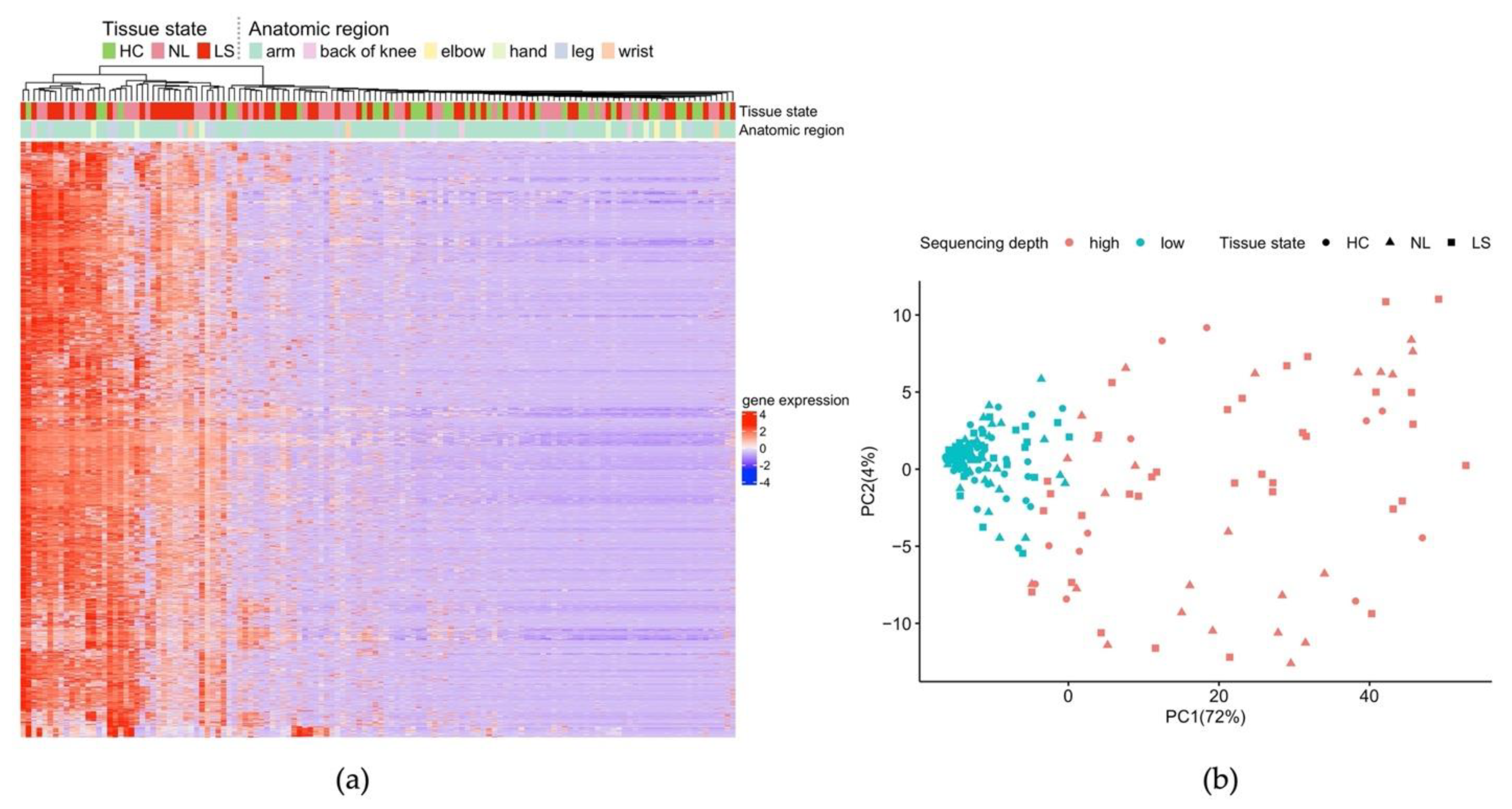
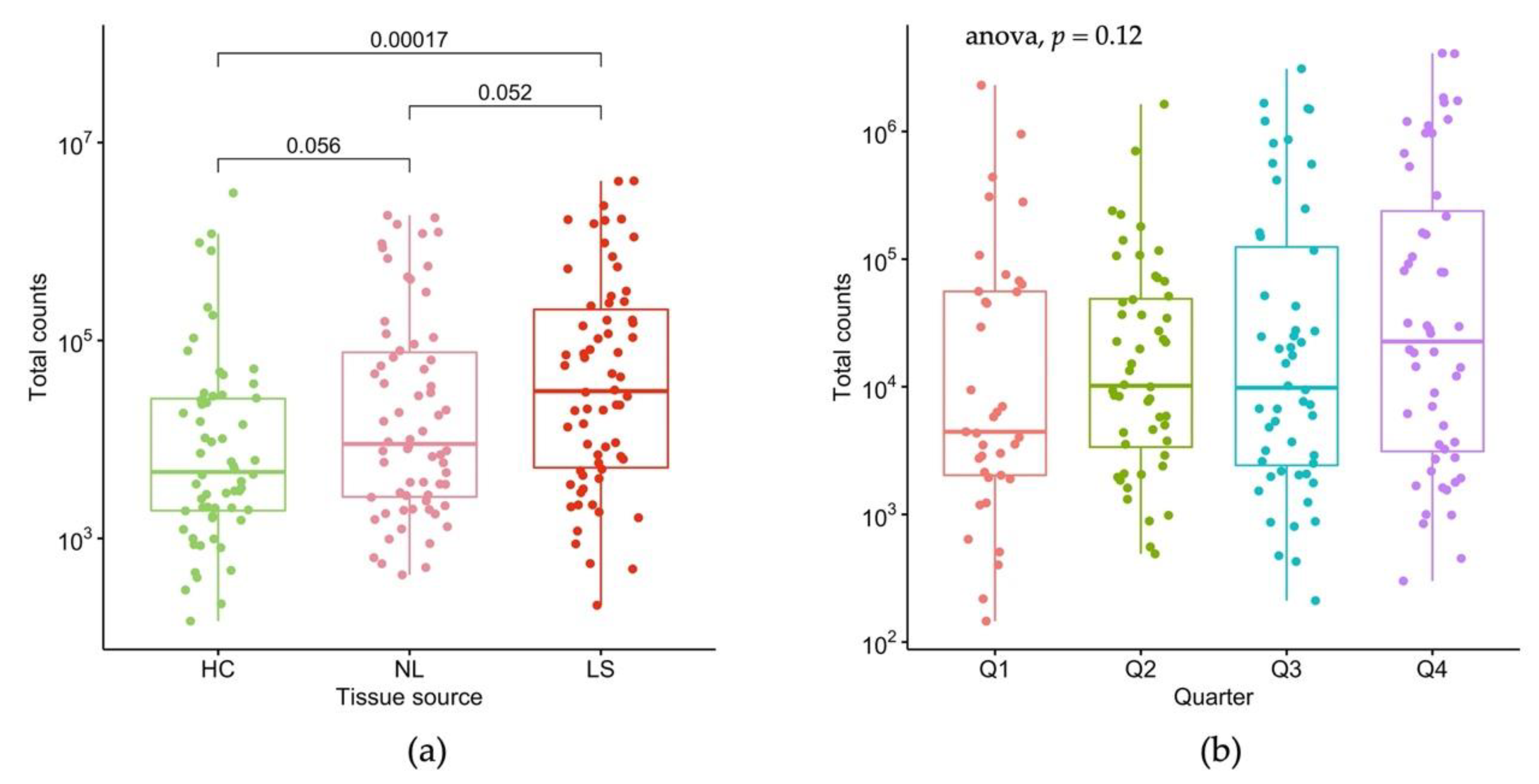
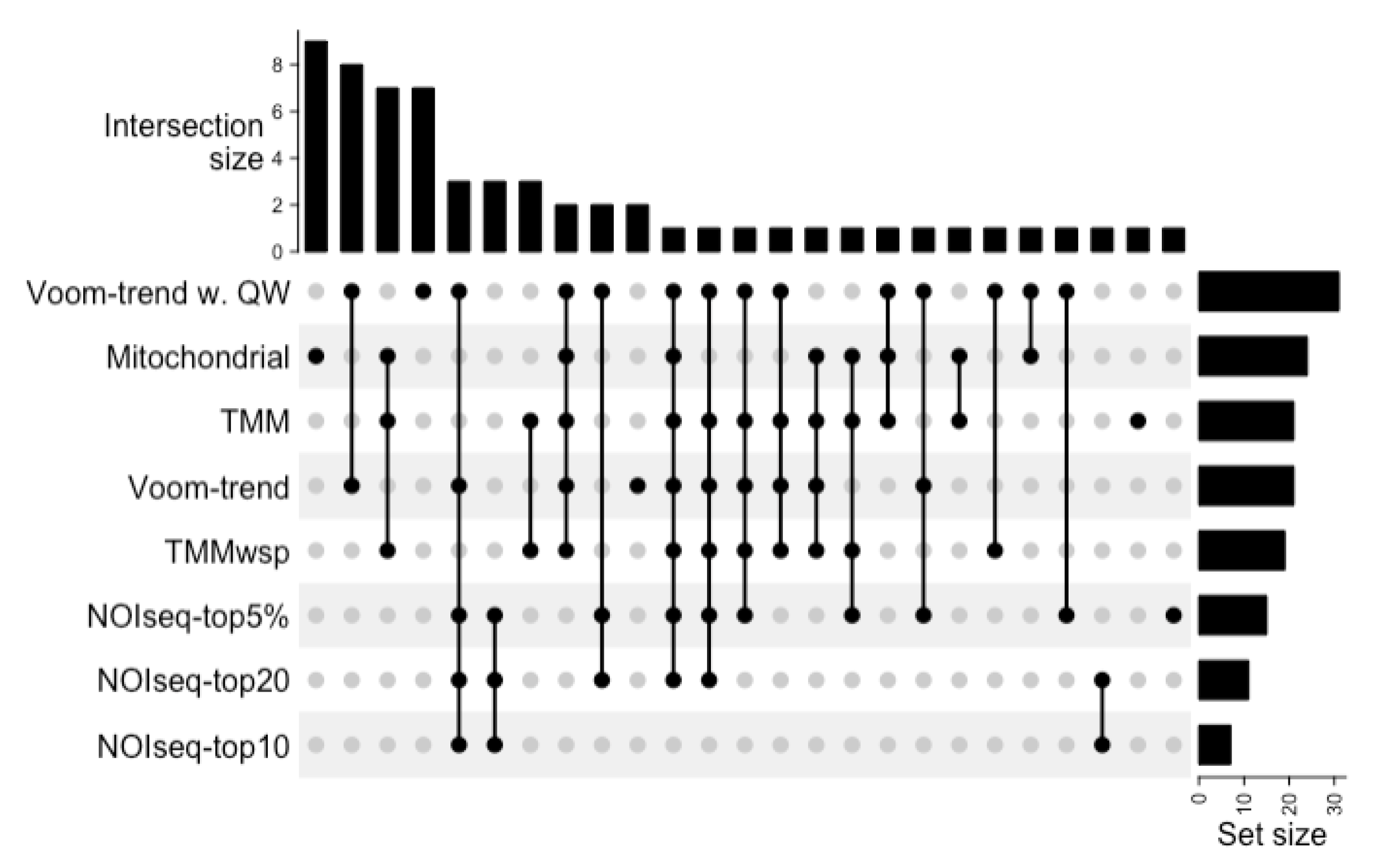
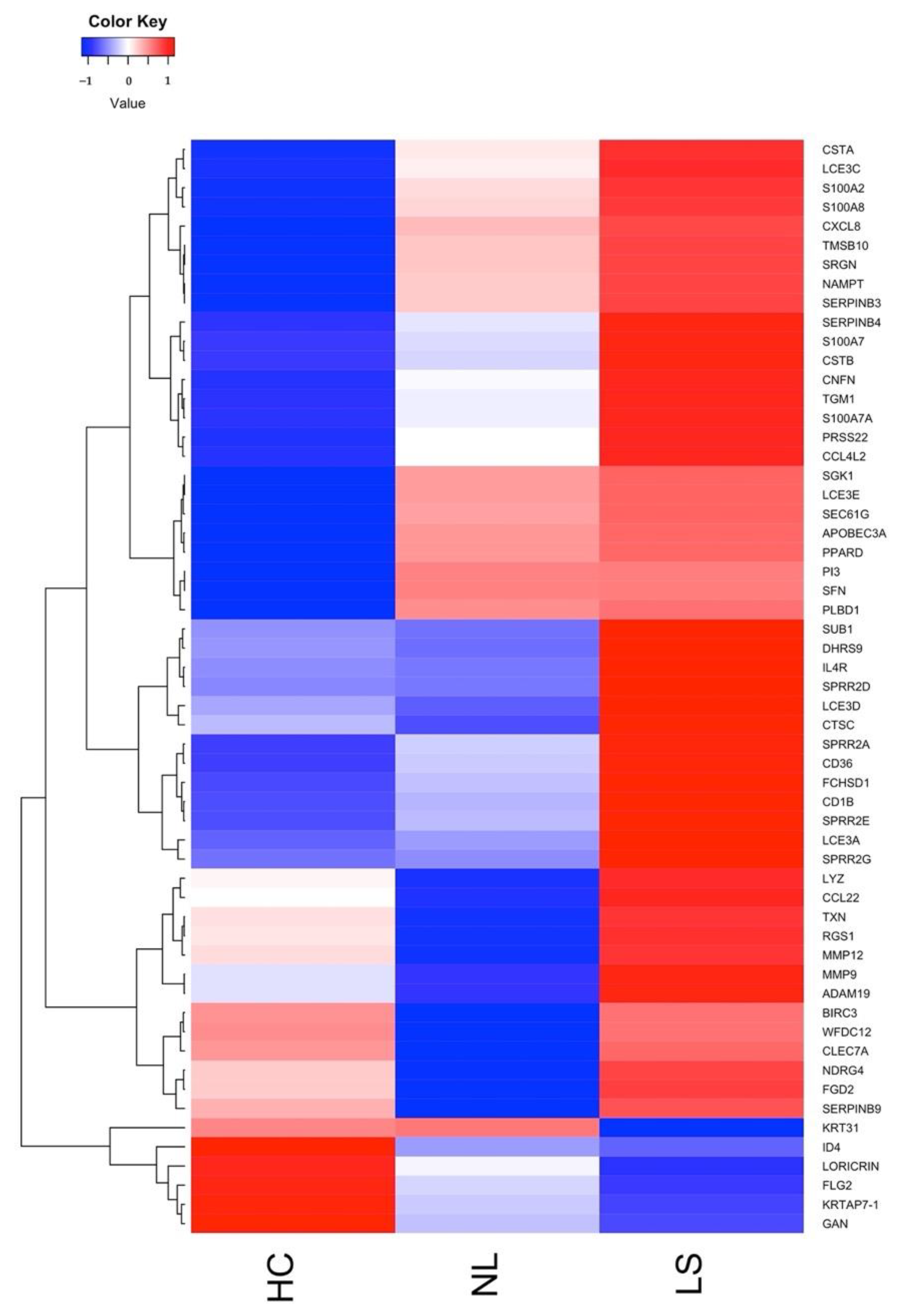
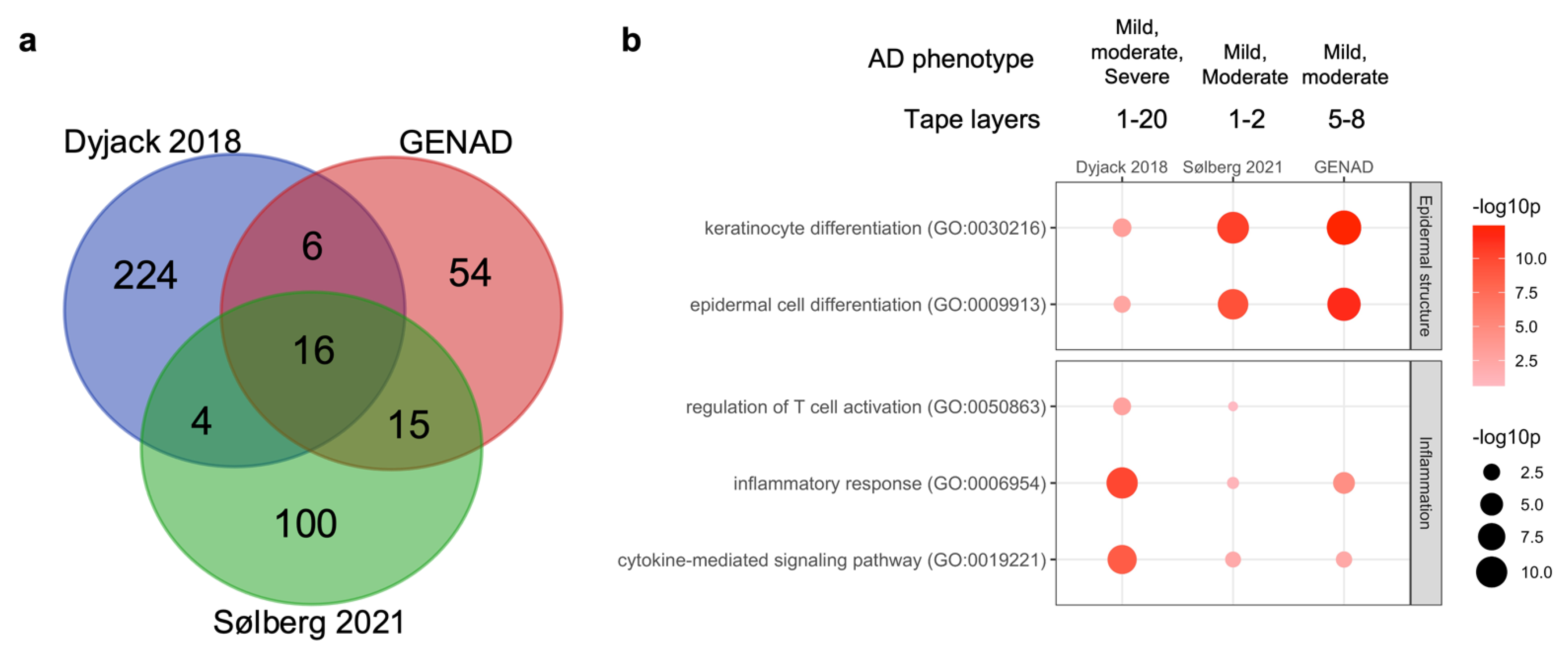
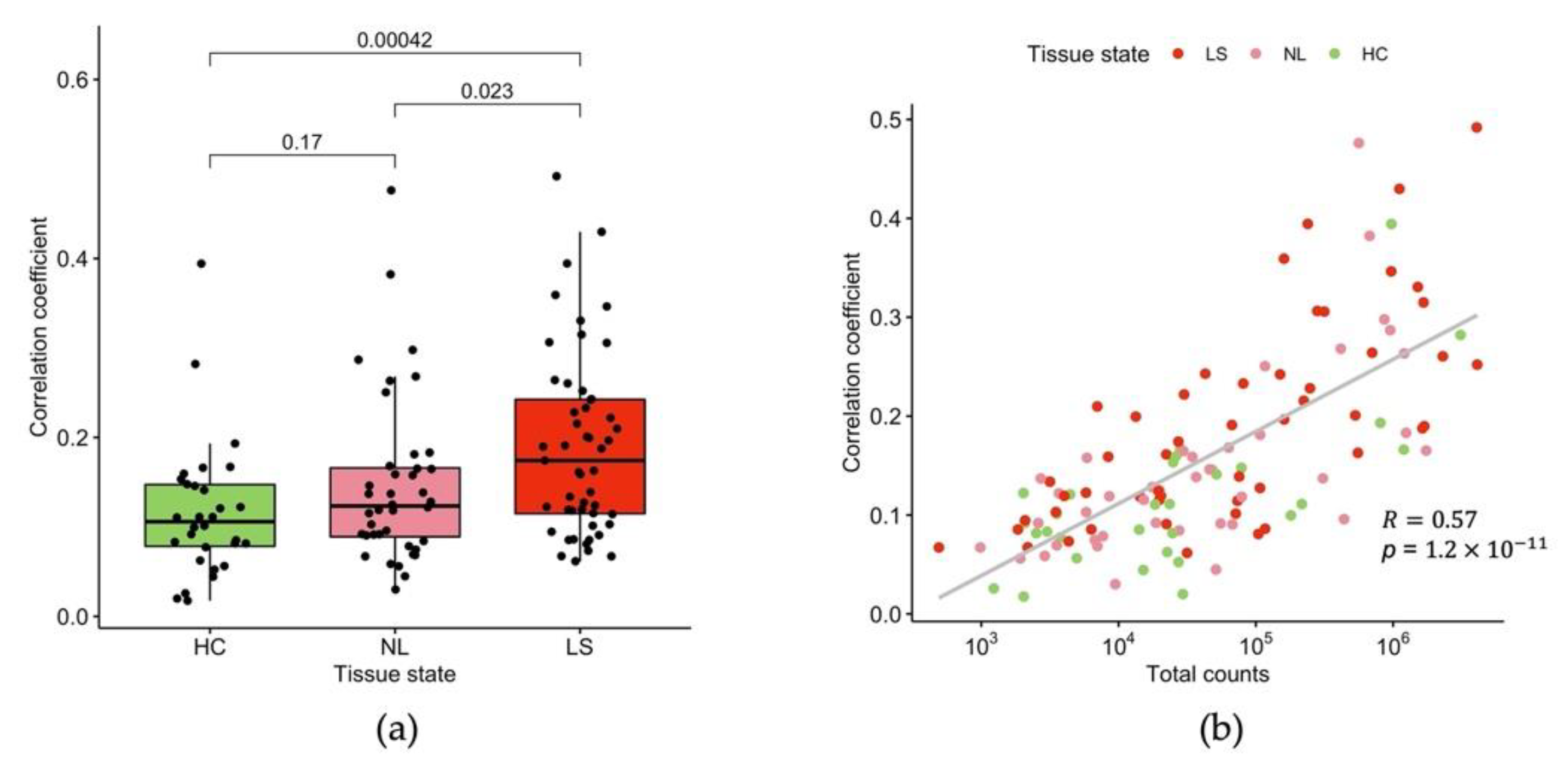
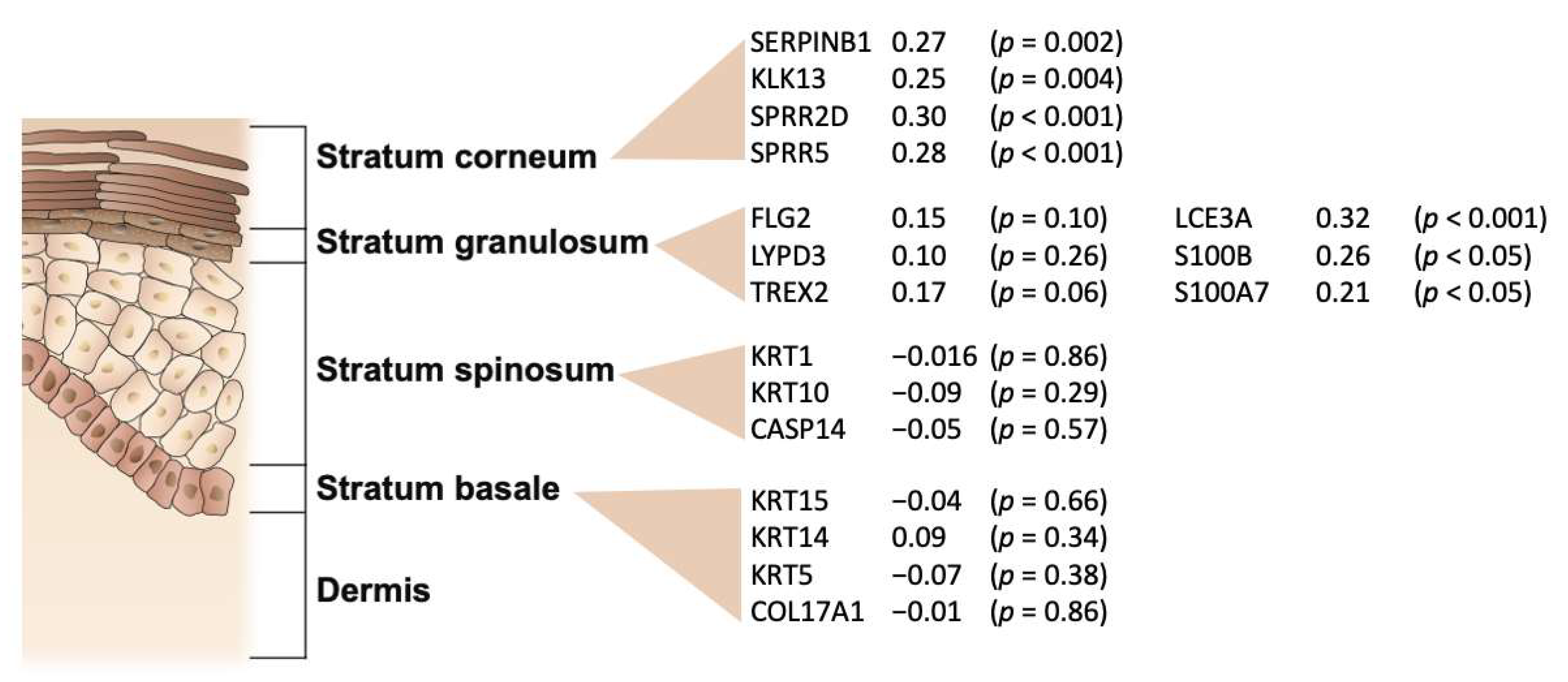
| Transformation | DE Testing | DE Cutoff | DEGs (LS vs. NL) Total (Up/Down) 8 | Accuracy (Up/Down) 9 |
|---|---|---|---|---|
| RLE 1 | edgeR glm fit | FC > 2, padj < 0.05 | 520 (4/516) | 1.15% (0/6) |
| TMM 2 | edgeR glm fit | FC > 2, p < 0.05 | 263 (226/37) | 8.37% (21/1) |
| TMMwsp 3 | edgeR glm fit | FC > 2, p < 0.05 | 242 (196/46) | 8.68% (19/2) |
| ZINB-WaVE 4 | edgeR glm weighted F | FC > 2, p < 0.05 | 212 (122/90) | 5.19% (10/1) |
| ZINB-WaVE 4 | DESeq2 | FC > 2, p < 0.05 | 78 (56/22) | 7.69% (6/0) |
| Voom-trend 5 on TMM data | limma | FC > 2, p < 0.05 | 92 (71/21) | 22.83% (21/0) |
| Voom-trend 5 with quality weight on TMM data | limma | FC > 2, p < 0.05 | 168 (151/17) | 19.05% (31/1) |
| Mitochondrial gene set normalization 6 | edgeR | FC > 2, padj < 0.05 | 333 (251/82) | 8.11% (24/3) |
| VST 7 | DESeq2 | FC > 2, p < 0.05 | 880 (3/877) | 1.02% (0/9) |
| TMMwsp 3 | NOIseq | Top-5% ranked | 115 (70/45) | 16.52% (15/4) |
| TMMwsp 3 | NOIseq | Top-20 ranked upregulated | 20 (20/0) | 55.00% (11/0) |
| TMMwsp 3 | NOIseq | Top-10 ranked upregulated | 10 (10/0) | 70.00% (7/0) |
Publisher’s Note: MDPI stays neutral with regard to jurisdictional claims in published maps and institutional affiliations. |
© 2022 by the authors. Licensee MDPI, Basel, Switzerland. This article is an open access article distributed under the terms and conditions of the Creative Commons Attribution (CC BY) license (https://creativecommons.org/licenses/by/4.0/).
Share and Cite
Hu, T.; Todberg, T.; Andersen, D.; Danneskiold-Samsøe, N.B.; Hansen, S.B.N.; Kristiansen, K.; Ewald, D.A.; Brix, S.; Rosa, J.C.d.; Hoof, I.; et al. Profiling the Atopic Dermatitis Epidermal Transcriptome by Tape Stripping and BRB-seq. Int. J. Mol. Sci. 2022, 23, 6140. https://doi.org/10.3390/ijms23116140
Hu T, Todberg T, Andersen D, Danneskiold-Samsøe NB, Hansen SBN, Kristiansen K, Ewald DA, Brix S, Rosa JCd, Hoof I, et al. Profiling the Atopic Dermatitis Epidermal Transcriptome by Tape Stripping and BRB-seq. International Journal of Molecular Sciences. 2022; 23(11):6140. https://doi.org/10.3390/ijms23116140
Chicago/Turabian StyleHu, Tu, Tanja Todberg, Daniel Andersen, Niels Banhos Danneskiold-Samsøe, Sofie Boesgaard Neestrup Hansen, Karsten Kristiansen, David Adrian Ewald, Susanne Brix, Joel Correa da Rosa, Ilka Hoof, and et al. 2022. "Profiling the Atopic Dermatitis Epidermal Transcriptome by Tape Stripping and BRB-seq" International Journal of Molecular Sciences 23, no. 11: 6140. https://doi.org/10.3390/ijms23116140
APA StyleHu, T., Todberg, T., Andersen, D., Danneskiold-Samsøe, N. B., Hansen, S. B. N., Kristiansen, K., Ewald, D. A., Brix, S., Rosa, J. C. d., Hoof, I., Skov, L., & Litman, T. (2022). Profiling the Atopic Dermatitis Epidermal Transcriptome by Tape Stripping and BRB-seq. International Journal of Molecular Sciences, 23(11), 6140. https://doi.org/10.3390/ijms23116140







